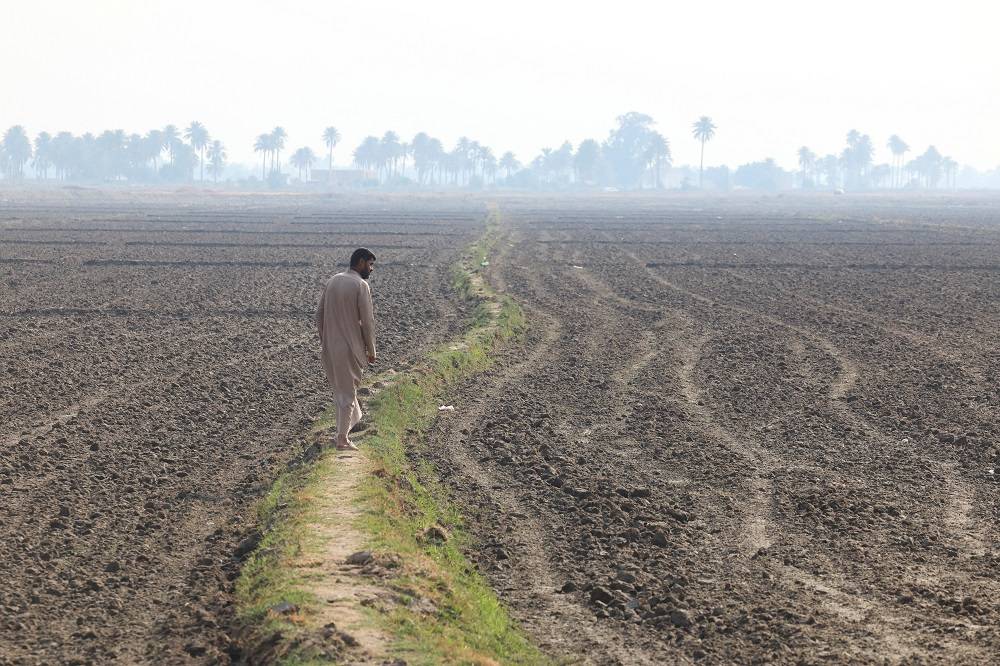As the clock strikes noon, Waheed Abu Sabeeh calls out to his seven-year-old daughter, Bisan, handing her a small pot and urging her to hurry. Just a few dozen meters from their tent, a charitable kitchen offers a lifeline: a single serving of cooked food in Gaza’s al-Shati (Beach) refugee camp.
Abu Sabeeh, 47, was displaced from his home in Beit Lahia in northern Gaza. He now lives with his wife and five children in a makeshift tent no larger than four square meters, pitched near an UNRWA school-turned-shelter in western Gaza City.
Like thousands of others driven from their homes by war and poverty, Abu Sabeeh has little to feed his family. “We survive on what the charity kitchen gives us,” he says, his voice weary. “If it weren’t for them, my children would sleep hungry.”
Each day, Bisan, who should be in a classroom, joins a long queue of women, children, and men, clutching empty containers. The charity serves up modest portions of lentils, beans, peas, or rice, around 400 grams per person, with no extras.
For nearly 90 minutes each day, sometimes even longer, seven-year-old Bisan waits in line under the sun, clutching a small pot outside a charity tent in Gaza’s al-Shati refugee camp. On other days, she heads out early, hoping to beat the crowds.
“I go get the food to help my family eat because we have nothing at home,” she says in a soft, innocent voice.
The food she brings back rarely stretches beyond one modest meal. On days when the kitchen runs out, the family makes do with bits of zaatar or hummus, sometimes without even bread.
Her father used to run a small children’s goods shop in Beit Lahia, northern Gaza. But Israeli airstrikes destroyed his store and home nearly a year ago, leaving him and his family with nothing but a tent and the daily uncertainty of survival.
“Bisan waits for hours to bring back just a few spoonfuls,” the father told Asharq Al-Awsat.
“Sometimes she comes back empty-handed. Sometimes she gets caught in fights with other children, all pushing for food.”
According to Bisan’s dad, her behavior has changed. “She’s louder now, more aggressive,” he said. “She pushes to the front. She shouts. She’s learned that if she doesn’t fight for it, she might not eat.”
In Gaza, Mothers Wait Hours for a Ladle of Lentils
Every day, 51-year-old Faten al-Masri clutches a cooking pot and joins a long line of people hoping to receive a small portion of lentils or rice from a charity kitchen in Gaza’s devastated al-Rimal neighborhood.
Originally from Beit Hanoun in the north, al-Masri and her 13-member family have been living in a tent for months, displaced by war. With no flour available, they eat whatever the kitchen provides, often without bread or any other accompaniment.
“Some days, I wait more than three hours just to get a little food,” she told Asharq Al-Awsat, her voice heavy with exhaustion. “There’s no flour, no extras. Just whatever they’re offering. That’s all we have.”
Despite her chronic diabetes and the pain of standing for long periods, al-Masri says she has no choice but to endure the wait.
“My children are busy - one fetching water, another looking for something else,” she said. “I go because I must. I’m sick, but I can’t let my family go hungry. We have nothing.”
Her words echo the desperation felt across the Gaza Strip, where hunger, displacement, and the collapse of basic services have forced even the elderly and infirm to queue for survival.
Charity kitchens across Gaza - once a critical lifeline for displaced families - are now buckling under mounting pressure, with some scaling back portions and others halting operations entirely, Asharq Al-Awsat has observed.
Once able to feed hundreds daily, several kitchens have begun rationing the limited supplies they receive. Others have shuttered altogether, unable to keep up with the soaring demand and dwindling resources.
These kitchens are operated by a mix of international organizations, UN agencies, Arab charities, and local youth-led initiatives. But aid workers warn the situation is spiraling into what they describe as “more than catastrophic,” as war, displacement, and a deepening blockade leave thousands at risk of starvation.
Ali Matar, who helps run a charity kitchen in western Gaza, an area now crammed with displaced families from the north, says the food crisis is reaching a breaking point.
“There’s a clear shortage of canned goods, rice, lentils, and other staples,” Matar told Asharq Al-Awsat. “Suppliers are running out, and that’s severely affecting our ability to cook and distribute meals. Hunger is tightening its grip on Gaza.”
The soaring cost of what little food remains, such as beans, peas, and rice, is making it increasingly difficult for donors to sustain operations. Matar said the strain is pushing some humanitarian groups to shut down their kitchens entirely, as their storage shelves lie empty.
“Some of the Arab-funded and charitable organizations are now pooling resources just to keep cooking,” he said. “But if this crisis isn’t addressed soon, the consequences will be catastrophic. We could see dozens dying of hunger every week.”
Under mounting international pressure to halt its military campaign in Gaza and allow aid in, Israel recently said it would permit the entry of “essential” humanitarian supplies.
Aid groups, however, say the announcement comes too late with assistance blocked since March 2 and needs growing exponentially.










